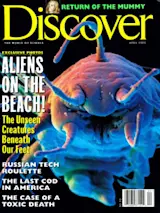It’s a show that always gets rave reviews: Spectacular, gut- wrenching. Nobody who’s seen a total solar eclipse wants a refund. And that’s not surprising. Having been eclipse astronomer for three expeditions into the moon’s shadow, I’ve firmly joined the ranks of the addicted. Pack the bags, take the second job, put an extra mortgage on the house--whatever it takes to position yourself precisely beneath the moon and sun.
It isn’t easy. The shadow of our nearest celestial neighbor barely reaches Earth. Most people find themselves outside the narrow black umbra where noon turns into the twilight zone. Instead they gaze upward from within the much wider band that sees a partial eclipse, the kind that will occur in Florida on April 29. But partial eclipses are like partial vacations; they’re not really satisfying. You can’t even look at them without eye protection, like number 14 welder’s goggles. No, it’s totality you want.
But it’s totality you will not get if you wait for the shadow to come to you. We’re in the midst of a major eclipse drought that began in 1979 and will not end until a coast-to-coast total eclipse slashes across the United States on August 21, 2017. So if you want darkness at noon, you must make a pilgrimage. And you don’t have too terribly long to think about it. The odd U.S. eclipse scarcity will infect the entire world like a computer virus in a few years. Only three more eclipses will cross easily accessible regions between now and the next century. After that they become more and more difficult to reach.
For reasons explainable only by the merciless laws of chance, the first dozen totalities of the new millennium will fall almost exclusively over oceans or near the poles. The closest they’ll meander to us and still make landfall will be Africa (in 2001, 2002, and 2006) and China (in 2009). They haven’t always been so elusive. In 1925 a total eclipse was a hit on Broadway, and eclipses have paid us courtesy calls once or twice a decade throughout most of our history. The present 38-year hiatus is a unique experience for our nation. So when and where are the final totalities of the millennium?
The first is October 24, this year. A one-minute eclipse will sweep across northwestern India before skirting the fringes of Calcutta. These areas are likely to be clear, since the monsoon will probably have departed several weeks earlier. The moon’s shadow will then continue across Thailand and Vietnam and into the South China Sea, where the length of totality will more than double. Unfortunately, so will the chances of dismal weather. Here’s a tip: if you’re planning an eclipse vacation, give less weight to the length of the eclipse and more to the chances of good weather.
There is no total eclipse anywhere next year, but an eclipse in 1997 will take a challenging route across Mongolia and Siberia. Then comes a seductive four-minute blackout on February 26, 1998, over St. Kitts, in the Caribbean. Finally, the century ends with the August 11, 1999, total eclipse, whose path will take in England, France, Eastern Europe, and Turkey.
This month’s skimpy partial eclipse in Florida may be a blessing if it motivates North Americans to start plotting an overseas odyssey, because the unforgettable experience of a total eclipse will come only to those who take the trouble to align their vacations with the elusive shadow of the moon.














